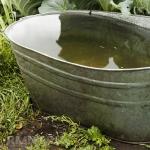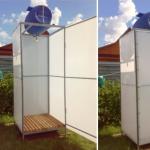One of the necessary equipment for our workshop is a forge. If you do more than just cold forging (), then you can’t do without it. In principle, it is now possible to buy almost everything, including this product. But when you see the cost (and the price for the cheapest models starts from 48,000 rubles), the thought involuntarily arises: is it possible to make it yourself? The answer is simple - you can, and quite simply.
Traditionally, coal (wood or stone) is used for such a “firebox”. But considering that we have no problems with gas in our country, we will consider just such a design. From a practical point of view, it is much more convenient and easier to manufacture. It is worth noting that in in this case it makes no difference what kind of gas it will be - main gas or from cylinders.
Advantages of a gas forge
- Ease of construction. If only because there will be no usual grates in such a stove.
- Possibility of adjusting the heating temperature.
- Cheapness and availability of fuel.
- Low manufacturing costs.
- Mobility. Given its light weight, it is easy to carry from place to place.
Forge designs
It should immediately be noted that there is no single standard for such a forge. It is only necessary to comply with certain requirements for working with gas equipment. The main thing is to understand the principle of operation of the oven and heating of workpieces. And the dimensions and location of the main constituent elements are at the discretion of the user.
Each amateur blacksmith arranges a forge “for himself”, how it is more convenient and expedient to use it. For example, instead of the usual masonry, you can install a thick-walled metal tank under the stove. Some craftsmen even adapt an ordinary bucket for these purposes.
Actually, it all depends on the imagination of the amateur “designer” and his capabilities. What do you need to know? There are 2 types of such stoves, and it is impossible to say unequivocally which “model” is better. Let us briefly consider the design principle of each of them, and the choice is at the discretion of those wishing to engage in hot forging of metals.
All descriptions below are just individual examples designs.

Open
It is a metal “form” that is installed on a fireproof base. This could be a small concrete area (floor), several fireproof bricks laid nearby. It is advisable to mount a stand, in the lower part of which there is a tray for placing parts to be heated. On the sides - vertical racks, which are fastening elements for installation from above gas burner. Naturally, its nozzle should be directed downward.
Smoke with this design deleted naturally, so there is no need to install a “hood”, which greatly simplifies the design. However, it must be taken into account that such a forge should be placed either in the open air or in a well-ventilated room where there is no risk of smoke.
The undeniable advantage of this “model” is that parts can be heated on a pallet different sizes, since their dimensions are not limited by the dimensions of the stove chamber. They are determined by the free space between the side posts.
Burner
Requires a separate description. This design element is integral part any blacksmith's forge. For its body (as an option) a stainless steel pipe is taken. One end is either welded tightly or closed with a removable lid.
A metal mesh is mounted at the other end. The diameter of the holes is selected experimentally, depending on what kind of “torch” is required to be obtained. The material is also “stainless steel”, a thickness of 2 mm is sufficient.
On the side, not far from the “plugged” end, a pipe is “welded” through which a mixture of gas and air will be supplied. In turn, another small-diameter pipe is welded to it, through which gas is supplied (air is supplied through the main one). It comes from the compressor, to which the supply (main) pipeline is connected.
To improve the quality of mixing gas with air, an impeller is placed next to the mesh.
How to properly adjust the operation of the burner is a separate big topic that we will discuss later.
Closed
It differs primarily in the type of traction. It is carried out forcefully, using a fan. By the way, this option, according to experts, is preferable, as it provides better ventilation of the room.
The furnace body (in the shape of a cube) is made of fire bricks(the so-called “fireclay” is used, which can withstand high thermal influences). Forge sizes for household use small - a side of 0.8 - 1 m is enough. A metal “lid” is installed on top, which is often called an umbrella. Recommended sheet thickness is 4 mm. Prerequisite high-quality operation of the forge - complete tightness of the internal volume.
What is necessary to maintain the combustion process? Firstly, gas. Therefore, there must be a hole in the side wall to insert the burner. Secondly, it is necessary to install a smoke removal system. Minimum dimensions channel - 30 x 30 cm. It should be taken into account that its height is from 4.5 m, no less.
As an actuator, you can use, for example, a motor from an old vacuum cleaner or from a car heater.
In order to be able to load parts into the forge for heating, it is necessary to provide a door. Therefore, you will need to leave a “window” in the wall into which to install a metal frame.
- If you make a cutout in the back wall of the forge, ventilation will improve significantly. In addition, it will be possible to heat up longer parts.
- For ease of working with the forge, it is advisable to install it on a metal stand (table). The height is chosen arbitrarily.
- If you have to work with details different sizes, then it is advisable to make 2 - 3 forges, differing in size. They are installed next to each other, and the air and gas supply can be carried out flexible hoses. This will allow them to quickly switch from one burner to another.
- It is also necessary to provide for the installation shut-off valves on every highway. It is better to use regular valves rather than ball valves, as they provide smoother adjustment.
Comments:
Most metal shops require a forge. If you have to work not only with cold but also hot forging, then you can’t do without it. Everything is allowed necessary equipment easy to purchase, but the cost of a forge is quite significant, price range starts from fifty thousand rubles. Therefore, sooner or later the idea of making a forge with your own hands comes to the mind of any workshop owner.
Traditional forges use forges that burn either charcoal or coal (coke), but there are also varieties that use petroleum products or gas as fuel. We are a country with the largest reserves of gas, the price of which is quite low, so a forge gas forge, made with your own hands from scrap materials, taking into account your preferences, will become the best option for any blacksmith.
Making it with gas is not only easy, but even much simpler than traditional coal options.
The efficiency of operation on gas is very high, and you can use not only the main gas natural gas, but also the one sold in cylinders.
Advantages of a gas forge

- The design of such a “hearth” is in many ways simpler than coal options, if only because it does not use grates.
- Regulating the gas supply, and therefore the combustion temperature, is much easier than in other varieties.
- Due to its weight, such equipment can rightfully be considered mobile. It can be easily transported to the desired location.
- The production cost is quite low and will not undermine the master’s budget.
- Availability and cost of gas are not comparable to other competitors.
Any craftsman with basic work experience will be able to build a gas or coal forge with his own hands if he has the appropriate materials, tools and a drawing of the future equipment. The figure shows a very interesting option gas forge, but when manufacturing it is not necessary to blindly adhere to it, every craftsman can make his own additions or simplifications to it.
After all, there is no single generally accepted standard. If you comply with the basic safety requirements during installation and you are satisfied with the efficiency of the forge, then the design features are not at all important. Change the size, appearance, design features, make the forge for yourself, your passions, growth, strength. Even such a seemingly eternal requirement as the base of a hearth made of refractory brick is not an immutable dogma; many blacksmiths make do with a leaky bucket coated with a layer of clay or even a thick sheet of heat-resistant steel. But still, let’s briefly look at the two main options for a gas horn.
Return to contents
Open forge model: instructions

It is a fireproof base in the form of a tray, platform or table with a recess. Bricks or other fire-resistant base are laid at the bottom, on the sides are stands made of bricks or steel, on which the gas burner will be mounted. It must be positioned so that the nozzle is directed downward, into the center of the refractory pan.
The design is primitive, but effective, it does not even need an exhaust duct, the smoke will dissolve naturally. But this is if such a fireplace is installed outdoors, under a canopy or in a well-ventilated area.
Since the shape of the forge is open, there are no restrictions on the size of the workpiece, which is very attractive to many craftsmen.
Return to contents
Closed model of a gas forge
The main difference from the open variety is that such a forge is framed in a body, usually in the form of a cube, and there is a forced exhaust. The body is usually made of fire bricks with a metal lid that extends into the hood. The dimensions of closed forges are small, for home use it does not exceed 80x100cm. You will need to insert a door into the front panel.
There is a hole in the side wall for mounting a gas burner. An important condition is to install a forced exhaust (with a 30x30cm channel), for this they often use engines from an old vacuum cleaner, car heating oven, etc.
Forge
Portable forge design
This type of forge will be appropriate if there is a need for rare repairs, in field conditions, transfer from one place to another and the like. In most cases, portable forges are made in a collapsible version. The main disadvantage of this type of forge is its low productivity, as a result of which it cannot be used for forging large products, as well as when performing large-scale work.
Portable forges are most often made by hand, as a result of which they can have completely different designs. A portable forge in most cases represents metal table, which is lined with refractory bricks. The most important part of this type of forge is the tuyere. To maintain fuel combustion it is used forced submission air, it is performed using mechanical devices in the form of hand or foot bellows, as well as using a fan, etc.
Can be used as fuel for the forge various fuels: gas mixtures, liquid fuels and solid fuels. Liquid forms are of petroleum origin: tar, fuel oil, gasoline, kerosene, petroleum. Solid fuel can be in the form of peat, coal, coke, firewood and the like.
Possibility to make a forge yourself
In order to make a forge yourself at home, you can use various available materials and tools; this does not require the presence special equipment. First of all, you should decide for what purpose you need a forge. From this you can find out the temperature to which the forge will have to heat the workpiece. As a result, knowing the required temperature, you can select necessary design, as well as the fuel on which it will run.
The design of open models is more practical, but they have a certain drawback - they are not as economical as closed models. Therefore, it is worth thinking about what to choose. For an open forge it is best to use gas fuel, whereas for a closed rut, hard is best.
To create a closed forge using improvised means, you can use the following materials:
1. fire bricks;
2. hood;
3. injection burner;
It is necessary to form a cube from bricks with a cavity inside, as well as a hole. The cube-shaped brick structure should be carefully secured using reinforcement or a frame made of other strong material. The burner must be fixed in one of the side bricks by entering the hole. To create safety and comfort of work, the hood should be mounted at the top of the structure at a convenient distance.
To make a forge open type you should use the following materials:
1. frame made of steel or bricks;
2. grill (frying pan with holes);
3. source of air supply in the form of a bellows, vacuum cleaner or fan;
4. solid fuel.
Using the frame, a table is formed on which the mesh must be laid. Using the selected device, air is supplied from the corresponding hole under the mesh. To regulate the automatic air flow, it is recommended to install a tap. In the case of mechanical regulation, the flow will have to be regulated independently.
Fuel is placed on the grate. First, wood chips and larger firewood are placed, then coke is added. It is necessary to ignite the fuel and turn on the blower, the workpiece is placed on the coke. You can also pour a little coke on top of the heated iron. As a result, a small vault is created in the thickness with a high temperature inside it. Instead of coke, it is quite possible to use ordinary wood waste. You can also use other various devices inherent in industrial installations.
Comments:
A forge furnace (in other words, a forge) is necessary for welding or forging metal in any forge, since this work is usually carried out at fairly high temperatures, not counting “cold forging”.
A forge (forge) is necessary for forging metal. It tolerates very high temperatures and should be in every forge.
If you wish, you can make forged items yourself and at home. To do this, you will need to construct a forging furnace with your own hands. There is a wide variety of such forges; they differ only in the type of fuel used.
Some features
There are several types of fuel - solid fuel, charcoal or coal, firewood and coke. Experienced blacksmiths prefer fuel such as coke, but it costs much more than regular coal. Although its consumption is much less than coal, about 5 times.

If we talk about metal forging artistic style, then this is the best fuel to use. Coke will give a fairly high hearth temperature. And because of all this, forging will be performed well, and there will not be a lot of soot and waste in the form of slag.
If you have decided on coke, then it is best to purchase coke. This is the same coke, only much smaller. If you take a large one, you will still need to split it into small pieces. This will take a lot of time, which you can spend usefully.
There are also furnaces that run on gas or liquid fuel, but this fuel option is usually used in larger-scale production.
The forge furnace is quite simple to operate.
The working surface is the place where the main forging work is done. Coal burns on it, which will heat the steel blanks. At the moment, there is a wide variety of structures and designs of such forges. They have their differences due to the fuel that is used on them.
Return to contents
DIY forge furnace

Let's talk about how to make a forging furnace yourself, and if you don't have the time or desire, you can order it from specialized factories. There are 2 types of ovens: closed and open.
The closed type of the stove is equipped with a special-purpose chamber; it is intended for preheating a metal workpiece. This type is the most economical, since its use requires minimum costs electricity.
However, there are restrictions on the size of the workpiece; only those that match the dimensions of the heating chamber will be suitable. One of the best forges for forging closed type is one for which gas is used as fuel.
The open type is usually heated using solid fuel, it is poured onto the grate from above, and air will be supplied below. In this type of forge, the workpiece must be placed on fuel. Using this type of stove, you can perform forging on fairly large workpieces; there are no size restrictions.
The main part of the stove is the table; on its upper part there is the hearth itself and the necessary preparations. It is advisable to make the height of the furnace according to the height of the blacksmith, while the table will fluctuate within the normal range from 700 to 800 mm. The surface can be any size you want, but it is customary to make it 80x80 cm or 100x150 cm.
To forge large metal workpieces, it is enough to increase the size of the table; you can make a special removable tabletop. It is made using corners and metal plates the right size. In the center of the table there is a hearth nest, which consists of a tuyere, as well as a grate, this is necessary for the air supply.

Diagram of a forge: 1 - exhaust pipe; 2 - exhaust hood; 3 - forge box; 4 - tuyere; 5 - pipeline from the blowing fan.
As a rule, a special brick with fire-resistant properties and clay are used for the furnace cover. All this will do this design quite heavy. And in such a situation, there is a way out if you are not satisfied with the weight category of this equipment.
You can make a stove out of metal; it will have a special lid made of 4 mm sheet and a cast iron grate. The grate must be placed in the center of the stove for forging metal. An important attribute for this stove is the hood, which is installed directly above it. You can make your own exhaust duct from metal with thin walls.
It is customary to begin forging metal directly by pouring fuel onto the grate. Many craftsmen lay out their preparations directly on the coals, and then add another layer on top. A small arch will be formed inside the coal, and the required temperature will rise.
Comments:
Nowadays, many men are inflamed with a passion for blacksmithing. The beauty of hot metal, transforming before our eyes into a beautiful forged product, is mesmerizing. Many of those who want to join this craft are frightened by the technical side of the issue: where to get or make a forge, what tools are needed, how to equip a forge so that there is no fire, etc. Here we will only consider the question of how to make a forge at home. All other issues can also be easily resolved if you have a strong desire.
Blacksmithing requires the presence of a forge and it is not so difficult to create even at home.
Varieties of forge
A forge is a special device for heating metal.
He might be the one different designs and use different kinds fuel. Single blacksmiths prefer to use a coke-fuelled forge. This type of fuel is quite different at a high price, but at the same time ease of use, as well as heat combustion and a small amount of waste offsets any costs. One of the varieties of fine coke is called “koksik”; most craftsmen prefer to use it, since there is no need to chop the coal themselves. Other types of coal, as well as charcoal, can be used as fuel, but why take the worst if you want to do everything well? Petroleum products or natural gas are usually used in large plants.
The second sign by which a forge can be divided into varieties is its type design feature, as openness, that is, there are open and closed views forge.

Scheme of the design of a mobile open-type forge.
A closed forge is a little more difficult to make than an open one. Its peculiarity is that the device has a special chamber in which the metal is heated. This type of forge is much more economical, but it imposes a limitation on the size of the workpiece outside its chamber.
The most common simple type of forge is the open one. It is extremely simply designed, as it consists of a certain container. A grate is installed on top, on which the coals will burn, and air is supplied from below. Such a forge has no restrictions on the size of the workpiece; it is placed directly on hot coals for heating.
Return to contents
Making a forge with your own hands

In general, this completes the creation of a forge. Now all that remains is to pour coals onto the grate, set them on fire, turn on the air supply and place the workpiece on the hot coals. For better heating, you can add a little more coal on top. The second layer creates a kind of dome, under which even more intense heating occurs, sufficient to melt any workpiece.




